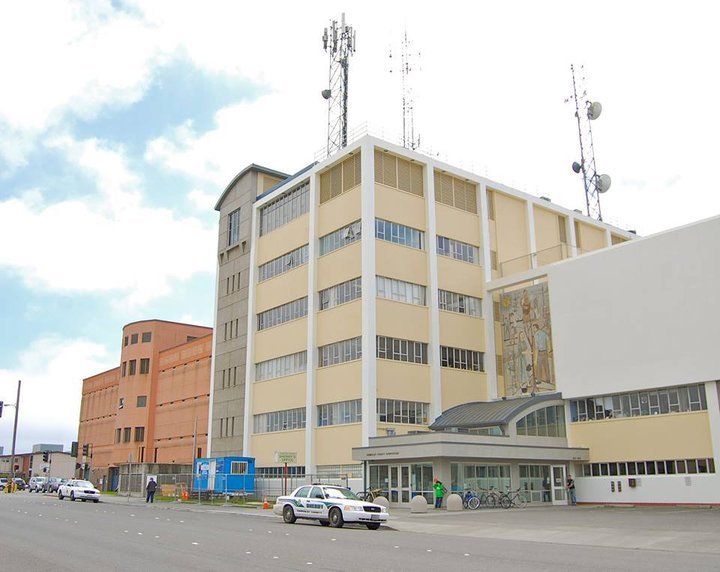
The Humboldt County Correctional Facility and courthouse. | File photo.
###
PREVIOUSLY: A New State Law is Changing How Courts Treat the Mentally Ill, But in Humboldt It’s Not That Easy
###
Thanks to a 2018 state law, a sizable grant and some dedicated advocacy, Humboldt County has begun to change the way it interacts with mentally ill people caught up in the criminal justice system.
In short, people who might previously have been sent to jail, declared incompetent to stand trial or left largely on their own to navigate probation are instead being diverted into comprehensive mental health treatment plans.
“It’s really promising,” said Casey Russo, a deputy public defender with the County of Humboldt. A longtime advocate for mental health diversion, Russo said that while the program is still in its infancy here in Humboldt, he’s seen an increased level of collaboration between various county departments — and that’s already having a positive effect on the lives of clients.
Last year the Outpost reported on the passage of AB 1810, a state law that allows judges to reroute defendants from incarceration to customized mental health treatment programs. We also wrote about the decision from staff in the Humboldt County Department of Health and Human Services (DHHS) to not apply for grant funding.
At the time, the county’s deputy director of behavioral health, Paul Bugnacki, pointed to a variety of structural problems making it difficult for the county to launch a mental health diversion program. Those problems included persistent staffing challenges, his department’s capacity limitations and our region’s shortage of in-patient mental health facilities.
But this year the county did apply for funding, and in June the California Department of State Hospitals awarded DHHS nearly $1 million — $979,800, to be exact — to implement the Pre-Trial Felony Mental Health Diversion Program.
The grant funds can be used over the next three years to pay salary and benefits for mental health staff, including clinicians, case managers and peer coaches.
Bugnacki said a team has already been assembled, and while dollars for mental health treatment remain scarce, he believes this approach can save money in the long run.
“Some of these individuals that qualify for these [diversion] programs were going to touch our system in one way or another,” he said, “whether they were admitted to the ICU CSU [the county’s Crisis Stabilization Unit], placed in Sempervirens [the county’s acute-care psychiatric facility] or arrested and treated in the jail.”
The diversion program has served to close some of the frequent communication gaps between DHHS and the court system, including the Public Defender’s Office, the District Attorney’s Office and Humboldt County Superior Court.
“It’s been difficult historically to pin the Mental Health Branch down on what sort of resources would be available for [an individual’s] treatment plan — and how quickly,” Russo said. “Now, not only can we get on a path to divert someone from the criminal justice system, but we’re building a relationship, a bridge to Mental Health. We have quicker correspondence. We’re getting to know them better and vice versa so we can more quickly access mental health resources for our clients.”
A diversion team, consisting of personnel from the participating county departments, has been meeting via video conference every other week. In a phone interview last month, Russo said that nearly two dozen people had already been placed on mental health diversion, meaning each one has been assigned a treatment program specifically catering to his or her particular circumstances.
Once a client is approved for diversion, Russo explained, they can meet with a case manager who conducts a comprehensive mental health evaluation and “wraps them up” in services right away.
“So often, historically, you might get someone referred to Mental Health, but they’d have to go to [the county office] and try to schedule an appointment, which might be three four weeks down the road,” Russo said. “There’s so much opportunity for that not to work out. Now we intercept them right away. They get quick access to services and medication, quick appointments — and there’s just an ongoing discussion about ways that we can address residential needs.”
The county has struggled over the years to line up sufficient housing stock for people with dual diagnosis, meaning they suffer from both mental illness and substance use disorder. Russo and Bugnacki said the diversion team has been working toward solutions on that front.
”So there’s a lot to be done,” Russo said, “but having that dedicated team available, it seems like we’ve made a lot of progress already. … Previously, the odds of success without being wrapped up in services, there was just lots of potential for relapse. But I feel far more confident now knowing that there is going to be someone checking up on this client regularly, making sure they have access to medications [and] the court. The chances of success are just going to be much better.”
Bugnacki agrees that this is a better approach. “Oh, absolutely,” he said. “Anytime you have somebody really suffering with mental illness or substance abuse, if they’re not in treatment they can be a heightened risk to themselves and maybe the community.” The clients must volunteer to be considered for diversion, which means they have some personal “buy-in” to succeed, he added.
And like Russo, Bugnacki said the new program has created a lot of new connections between disparate agencies and departments, including law enforcement, hospital emergency departments and community groups.
“So we’re really able to use all kinds of community resources to provide individuals with the things they may be in need of, including housing,” Bugnacki said. “It just opens up a lot of doors for folks.”
CLICK TO MANAGE